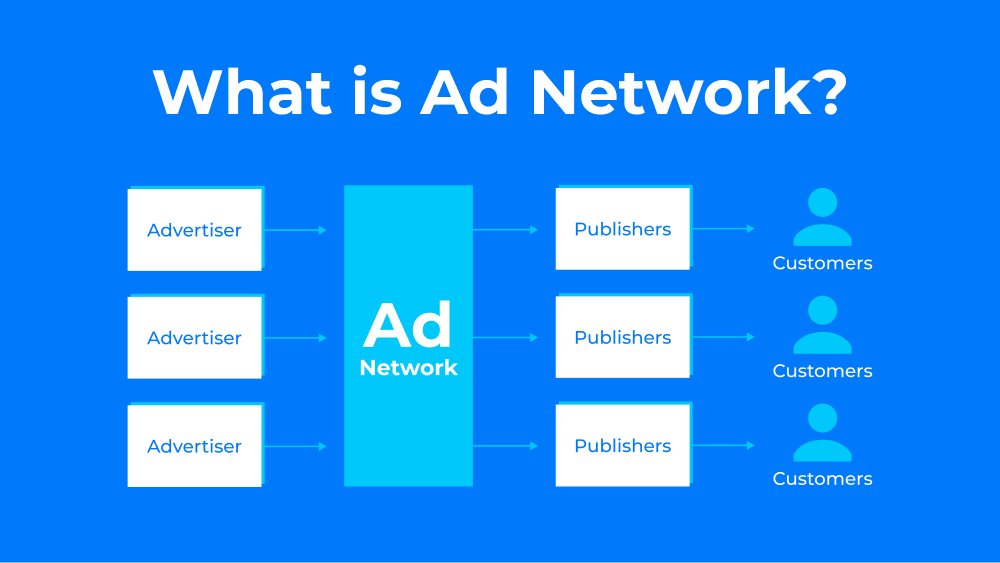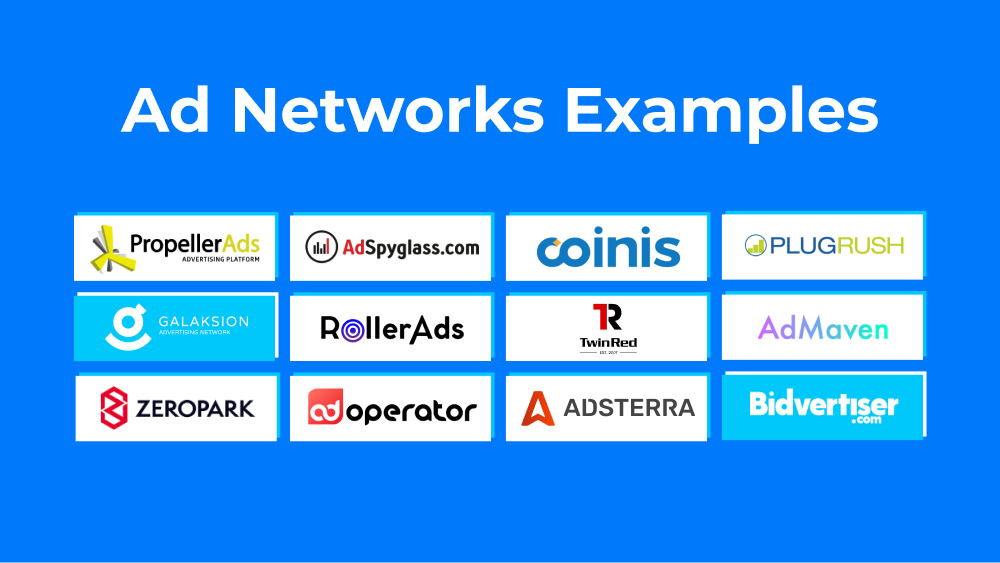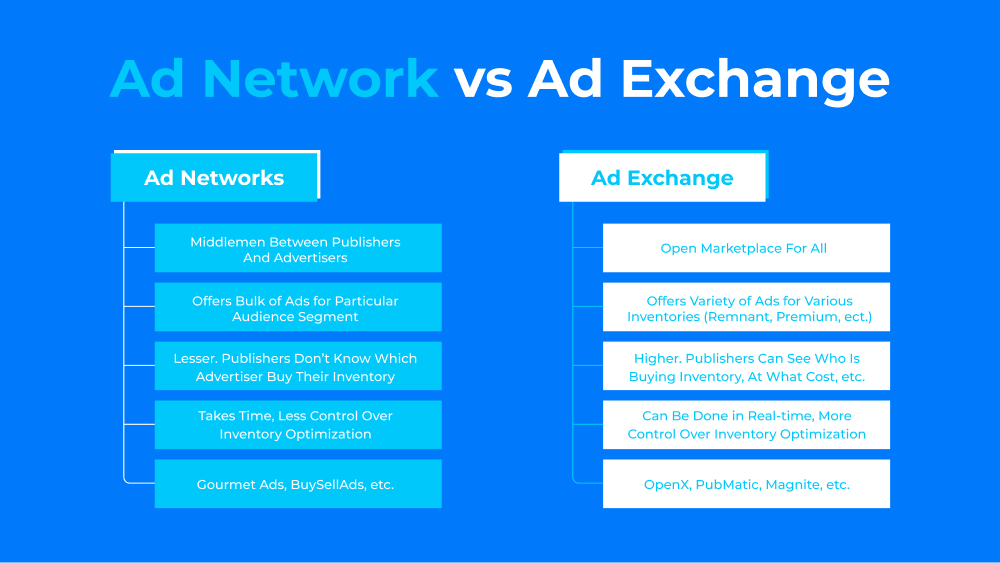In the early days of print publishers transitioning to the digital realm, they quickly realized the importance of generating revenue online. Their primary source of income had been advertising, so they set out to replicate this model in the online world. Monetizing their content through display ads seemed like the most logical approach.
Publishers could sell advertising space directly to interested advertisers, but the process was not without risk, as there was always the possibility of unsold inventory. Consequently, they needed a platform to sell their remnant inventory, and thus arose the need for such a system.
That’s where the ad network came in. If you don’t know what it is or how it works, it’s time to close that gap in your knowledge.
Table of Contents
Ad network definition in plain words: a company that collects ad space from many websites or apps, bundles that inventory, and sells it to marketers through one interface. In other words, a single digital ad network lets thousands of publishers meet thousands of advertisers without one-to-one deals. Understanding how does an ad network work is the first step to monetising content or buying efficient reach.
Below, we unpack core benefits, selection tips, and key questions for newcomers.
What is an Ad Network?
Digital ad accounts for about 50% of all advertising-related spending in the world. Therefore, now digital advertising is a powerful tool that modern advertisers can use.
An ad network is a special platform that acts as an intermediary between advertising market players. In digital advertising, there are 2 major components. The first one is the publisher and the second one is the advertiser. It is between them how the ad network operates.

In the modern world, it is used in online marketing and digital media. For a simpler understanding of the essence of network advertising, imagine a broker. Its task is to collect many impressions using the resources of different publishers. After that, they put the collected impressions up for sale. An advertiser interested in a particular display buys it as a digital product.
Now publishers are concerned about finding the right and effective ad networks that will allow them to expose affordable ad space to sell and earn. On the other side, advertisers are exploring the available ad networks in an attempt to find an effective tool to fulfill their goals and needs.
Evolution of Ad Networks
Ad networks, just like digital advertising, appeared almost simultaneously. It happened in the mid-90s of the last century. The emergence of new sites has led to the creation of all kinds of digital publishers on the Internet.
Even then, online advertising was in demand. But the fragmented nature of the proposals did not provide the desired effect. As a result, advertisers were rarely able to find their target audience using the tools available to them. Besides, publishers could not sell inventory on favorable terms. There was the problem of the supply being unable to meet the growing demand. The reason is simple – the infrastructure is weak in its effectiveness.
The problem of low efficiency was solved using advertising networks. They represented the publisher, which helped facilitate the whole process.
Interestingly, initially, ad networks only collected residual traffic that could not be sold through direct deals. Prices were set low. So they sold illiquid digital goods. But soon the situation changed.
How do ad networks work?
Ad networks receive inventory from publishers. After that, it sells the resulting inventory to interested advertisers.
For those who are interested in learning about the principles of operation, we advise you to get acquainted with the following.
- The ad network consists of numerous different publishers. It allows the advertiser to access the resources they need;
- Advertisers can directly set up a campaign. For these purposes, a control panel from the ad network they have chosen is provided. Another option is to use third-party ad servers. It is a good solution for those who use several networks;
- Advertisers set up all the parameters they need for the campaign to effective work;
- When a chosen advertisement is published, an advertiser can easily choose the order in which banners appear on the website using the modern ad network’s control panel tools. Direct communication with the publisher is not required.
Today it’s hard to sell all your inventory with just one ad network. Although earlier, when there were only fewer websites, this was enough.
Types of Ad Networks
Finding an ad network that fits the bill is rather easy. It is explained by numerous networks adapted to different topics, formats, and audiences that advertising will be aimed at.
There are 4 main types.
- Vertical. Such networks are focused on a specific topic. It can be business, health, cars, etc.;
- Premium. Such networks offer high-quality inventory created by the best and most popular publishers;
- Inventory-specific. Offer advertising resources that belong to a specific type. For example, mobile devices, video;
- Targeted. Gives you some targeting options. These helpful networks are built into the ad server used.

Various factors affect the cost of networking. Some advertising packages are sold at a fixed price. Others take into account the number of clicks, impressions, or bids.
Ad Network vs. Programmatic Ecosystem
The Programmatic modern Ecosystem is a system for auto-buying and also selling online advertising space. With its help, the advertiser is connected with the advertising exchange and impressions using cutting-edge algorithms and server software for automated buying and selling ads. Functioning is carried out with the help of industry-leading oRTB [Real Time Bidding] standard and SSPs [Supply-Side Platform], DSPs [Demand-Side Platform], Ad Exchanges, and DMPs [Data Management Platform] that act as programmatic ecosystem elements.
Conceptually, there are significant differences between a modern programmatic ecosystem and an old-fashioned ad network.
The operation of advertising networks is impossible without human involvement. The AdOps manager performs lots of important functions. It is the reception of advertisements, as well as setting up campaigns.
Instead of this, the programmatic world is powered by server-side and client-side software with the least human involvement. It leads to an unseen speed of ad trading, one such Ad Server can proceed with thousands of programmatic deals per second!
The rapid development of modern ecosystems for advertising according to certain algorithms leads to the fact that at some point the ad network can become an outdated and ineffective tool.
Ad Network vs Ad Exchange
In the modern digital world, an ad exchange is a server software that acts like an automated marketplace for selling and buying ads. As we mentioned above, the ad network was the first attempt of the advertising market to optimize deals between sellers and buyers using a one-stop platform.

Meanwhile, ad exchanges offer a more transparent, rapid, and efficient solution for buying and selling digital advertising. By utilizing algorithms, ad exchanges enable publishers to get the most competitive prices for their impressions. On the other hand, advertisers are allowed to launch more relevant and performance-oriented campaigns.
When it comes to buying as well as selling digital advertising, the exchange is a transparent and highly effective tool.
Ad networks vs. SSP and DSP
DSPs, just like an SSP, are essential components in today’s programmatic ecosystem. They are used in the online bidding process as client-side platforms for automated programmatic advertising.
To effectively manage an ad network, in most cases a manual method is required. Therefore, to participate in RTB, customers need self-served supply-side and demand-side platforms.
Using SSPs and DSPs, a connection is made to an Ad Exchange, which allows for the activation of programmatic advertising.
An ad network can be called an intermediary, as well as an effective aggregator at the same time. Instead of programmatic ecosystem elements, at the heart of his work is human labor, not programmable algorithms.
Ad networks and ad servers
To distinguish between an ad network and an ad server, it’s important to understand that an ad network utilizes an ad server.
At its core, an ad server is a powerful technology that enables advertisers to place their ads on specific websites or applications while allowing publishers to manage these ads effectively. Meanwhile, an ad network leverages this technology to manage ads and publisher inventory, helping to maximize the effectiveness of digital advertising campaigns.
Benefits of Ad Networks for Publishers
Connecting a single site to an advertising network can feel like hiring an instant sales team. Instead of emailing agencies one by one, you tap a marketplace that hustles on your behalf 24/7. Below are six publisher-specific gains that come with the plug-and-play model.
1. Instant Demand and Better Fill
The moment the tag goes live, global brands can bid on your impressions. Even a brand-new blog sees auctions instead of empty space, lifting fill rates from day one.
2. Higher eCPM Through Competition
Many digital advertising networks include header bidding or server-to-server auctions. Multiple buyers see the same impression, driving second-price bids up and pushing eCPMs beyond what a single partner could offer.
3. Unified Reporting and Faster Insights
A central dashboard tracks requests, revenue, and viewability in real time. Daily snapshots replace the maze of CSVs from scattered demand sources, freeing your team to act on insights instead of sorting data.
4. Access to Premium Budgets
Networks court top-tier advertisers you might never reach alone, think automotive, finance, or national retailers. Their larger budgets flow to quality inventory, boosting your average revenue per visitor.
5. Format Flexibility
Most networks support display, video, native, and even rewarded or interstitial inventory. You can A/B-test placements without negotiating new contracts, finding the mix that maximises revenue without harming user experience.
6. Reduced Operational Overhead
From ad-ops troubleshooting to payment collection, the network handles the heavy lifting. You keep production focused on content while the platform manages tags, fraud filters, and monthly payouts.
For publishers, the right digital ad network turns traffic into predictable income, streamlines reporting, and opens doors to premium demand. All while cutting the workload that normally drags growth. Plug in once, optimise often, and let the auction do the rest.
Benefits of Ad Networks for Advertisers
Buying media across hundreds of sites used to mean juggling contacts and insertion orders. Plug into a single digital advertising network, and that complexity drops to one contract, one dashboard, and one set of rules. Here are six advertiser-focused advantages that make networks an efficient path to reach, relevance, and ROI.
1. One-Stop Scale Through Aggregated Supply
A single campaign can appear on news, gaming, finance, and lifestyle properties within minutes. That breadth removes the need for individual deals and unlocks mass reach without extra paperwork.
2. Precision Targeting with Smart Algorithms
Machine-learning models analyse device, geo, viewability, and context in real time. Creatives only render when the impression matches your spec, showing how mobile ad networks work to cut waste while improving relevance.
3. Built-In Brand Safety and Fraud Shield
Pre-bid verification, ads.txt checks, and IVT filters block unsafe URLs and bot traffic before a penny is spent. Your brand message stays off sketchy pages, and budgets avoid invalid impressions.
4. Live Performance Optimisation
Dashboards update every few seconds, sending budget toward placements that beat CPM, CPC, or CPA targets. Underperformers throttle down automatically, stretching each euro for maximum impact.
5. Streamlined Buying and Billing
One insertion order covers all inventory; one invoice closes the month. Finance teams reconcile faster, and campaign launches no longer wait on multiple vendor approvals.
6. Flexible Creative Formats and Testing
Display, native, video, and rich-media units sit side by side. A/B-testing new messages or swapping creative sizes requires a few clicks, not fresh negotiations, letting marketers refine campaigns on the fly.
From instant scale to airtight brand safety, ad networks turn fragmented inventory into a single, optimised marketplace. Advertisers gain faster launches, smarter targeting, and clearer reporting. Proof that the right network partnership is a shortcut to efficient growth.
How Do You Choose the Best Ad Network?
Connecting a single site to an advertising network can feel like hiring an instant sales team. Instead of emailing agencies one by one, you tap a marketplace that hustles on your behalf 24/7. Below are six publisher-specific gains that come with the plug-and-play model.
With hundreds of advertising networks promising scale and efficiency, picking one can feel daunting. The checklist below breaks the search into six clear steps so you can compare options side-by-side and select the partner that fits your goals, budget, and risk tolerance.
Step #1. Set Clear Objectives
First, decide whether you want mass reach, niche audiences, or format depth such as CTV or rewarded video. A network that excels at mobile banners might lag in long-form video, so goals come before vendor calls.
Step #2. Evaluate Inventory & Formats
Look at ad network examples on the roster: premium news sites, indie blogs, or in-app traffic. Confirm the mix supports display, native, and rich media. If your plan leans on video, ask which players and codecs the digital ad networks support out of the box.
Step #3. Audit Targeting Depth
Ask what are ad networks offering beyond basic geo. Do they layer contextual, interest, device, and connection-speed filters? The richer the menu, the less you’ll spend on third-party data later.
Step #4. Verify Economics & Payment Terms
Transparent fees matter. Compare take-rates, minimum spends, and payment cadence. Net-30 is standard, but some networks pay publishers weekly, useful if cash flow is tight.
Step #5. Inspect Brand-Safety & Fraud Controls
Request a one-pager on IVT filters, ads.txt enforcement, and pre-bid verification. This shows how do ad networks work behind the scenes to keep bots out and content safe.
Step #6. Run a Pilot and Benchmark
Commit a small budget, tag every creative, and measure lift versus your direct buys or other digital advertising networks. Keep the winner; cut the rest.
Follow these six steps and the maze of options narrows to a short list that meets your KPIs, safeguards your brand, and pays on terms you can live with. Choosing well now saves countless hours of troubleshooting later and sets the stage for scalable, data-driven growth.
Our tech staff and AdOps are formed by the best AdTech and MarTech industry specialists with 10+ years of proven track record!

Conclusion
The ad network meaning has evolved from simple banner aggregation to a full stack of programmatic tools that serve both sides of the market. Pick the right partner, and you gain scale, safety, and efficiency without heavy tech costs. Treat network relationships as extensions of your team, monitor performance weekly, and adjust placements or bids as data dictates.
Seeking an efficient programmatic advertising solution? Contact us and we will provide you with the best one!
FAQ
Can I use multiple ad networks on the same website?
Yes. Many publishers stack networks to improve fill rate, but you should set clear priority rules to avoid latency and duplicate impressions.
What are the big four advertising networks?
Google AdSense/Ad Manager, Amazon Ads, Microsoft Advertising, and Yahoo/Verizon Media are often called the “big four” for global reach.
What targeting options do ad networks offer?
Common filters include geography, device, OS, time of day, contextual keywords, interest categories, and retargeting segments.
What is the minimum budget to advertise through an ad network?
Self-serve platforms may start at €50–€100, while managed-service networks often require monthly commitments of €5,000 or more.
How do ad networks ensure brand safety and fraud protection?
They integrate pre-bid verification, domain blocklists, ads.txt validation, and machine-learning fraud detectors to keep ads away from unsafe or invalid inventory.

